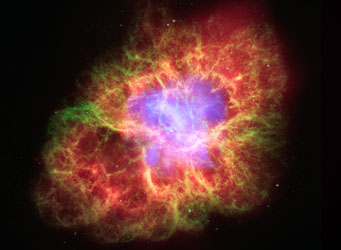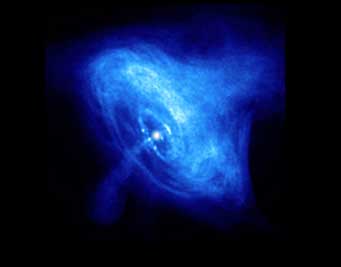Once thought to be a stable source in the sky, the Crab Nebula has erupted in another gamma-ray flare.
The Crab is at it again.

This composite image of the Crab Nebula combines a Chandra X-ray image in light blue with the Spitzer Space Telescope infrared image in red and Hubble Space Telescope’s optical image.
NASA / ESA / JPL
On March 3rd the Fermi Gamma-ray Space Telescope spotted a flare from the Crab Nebula, a spike in gamma-ray emission that’s three times greater than the average output. The Italian AGILE satellite detected it, too, and on March 4th both teams sent telegrams calling for more observations. As of yesterday, the flare is ongoing.
This flare isn’t the Crab’s first fit. Since 2007 AGILE and Fermi have detected about a half dozen events, the most fantastic that of April 2011, when the Crab erupted in an outburst at least 30 times brighter than the nebula’s norm. The new flare is the brightest since that event. These flares put out 1,000 times more power than the Sun does at all wavelengths.
Astronomers still don’t understand why these events happen. The Crab Nebula, or Messier 1, is the remnant of a supernova seen on Earth in AD 1054 and one of the brightest gamma-ray sources in the sky. Inside it the dead star’s core spins 30 times per second as a pulsar, shooting its lighthouse-like beam into space as it whirls. A hot, magnetized wind of electrons and positrons streams away from the pulsar and dumps energy into the surrounding gas, making it glow.

The Crab pulsar is the white dot in the center of the vortex revealed by NASA's Chandra X-ray Observatory. The inner ring is probably created when the pulsar's wind slams into the surrounding nebula, and energy from this collision makes the whole structure glow. Somewhere inside here gamma-ray flares are created.
NASA / CXC / ASU / J.Hester et al.
The pulsar’s wind could be to blame for the flares, says Fermi team member Rolf Buehler (DESY Zeuthen, Germany). He and his colleagues think that somewhere in the wind magnetic fields suddenly snap into new configurations, accelerating electrons that then emit the gamma rays as they corkscrew along magnetic field lines. These flares should originate within about one-third of a light-year from the pulsar and come from a region about the size of the solar system (that’s about 1/10,000 the size of the nebula).
But so far attempts to nail down the flares’ locations have failed. Gamma-ray telescopes don’t have great angular resolution, meaning astronomers need to use lower-frequency instruments to narrow in on an event’s place in space. Such efforts have turned up nothing: observations in radio, infrared, and X-rays haven’t detected conclusive signs of a flare.
“At the moment we are all a bit mystified,” Buehler says.
The Keck Observatory on Mauna Kea and the Hubble and Chandra Space Telescopes have already joined the campaign to try to catch the current flare at lower energies. Buehler says that they expect the event to last about 10 days, given previous behavior, but they’ve still found no connection between how bright the flare is and how long it lasts, so duration is anyone’s guess.
There’s a bit of irony in the Crab’s flaring behavior: the nebula used to be considered a steady emission source, and it’s often been used to calibrate observations in X-ray and gamma-ray astronomy. Detecting the variability has only become possible in the last five years or so with the advent of newfangled instruments.
NASA released a video (below) after the 2011 whopper, which does a great job explaining the flares and putting the Crab in context.
References:
R. Ojha et al. "Fermi LAT detection of a new gamma-ray flare from the Crab Nebula region." The Astronomer's Telegram, #4855. 4 March 2013. (Also see references therein.)
Fermi-LAT Collaboration. "Gamma-ray flares from the Crab Nebula." Science. 11 February 2011.
R. Buehler et al. "Gamma-ray Activity in the Crab Nebula: The Exceptional Flare of April 2011." The Astrophysical Journal, 10 April 2012.
M.C. Weisskopf et al. "Chandra, Keck and VLA Observations of the Crab Nebula during the 2011-April Gamma-ray Flare." The Astrophysical Journal, 1 March 2013.
 8
8
Comments
markLouis
March 7, 2013 at 1:41 pm
A couple of years ago NASA released data on terrestrial gamma-ray flashes NASA's Fermi Catches Thunderstorms Hurling Antimatter into Space, suggesting something like 500 such events happen every day. Now M1 is acting up. As if people didn't have enough to worry about, now gamma ray bursts seem to be showing up more often than people expected.
You must be logged in to post a comment.
Bruce
March 8, 2013 at 12:52 pm
Si, Senor Jamie Diaz, it is fantastic that we can see the wonders of the awe inspiring universe with the help of the “newfangled instruments” of today’s astronomers. To we who share a love for astronomy, the bible and the One who brought them both into existence, the verses of Psalms 19:1,2 are indeed beutiful. But when we invite others to consider such things, why even give offense, if even in jest? Paul advised, “Let your utterance be always with graciousness, seasoned with salt, so as to know how you ought to give an answer to each one.” (Colossians 4:6) If we speak or write in a tasteful, respectful way even those who don’t agree with us about creation may at least consider what we have to say. If you say to someone, look at this, but then you poke him in the eye so to speak, don’t expect a good reaction.
You must be logged in to post a comment.
Peter
March 8, 2013 at 5:33 pm
The blue in the x-ray picture is about 1 light year across; the visible nebula spans about 10 lyr. If it is flaring on the order of 10 days, it can only be coming from the white dot "in the center of the vortex."
You must be logged in to post a comment.
Bruce
March 9, 2013 at 6:12 am
In trying to understand this strange phenomenon I have some assumptions which I'd like to discuss. Wouldn't it be correct to assume that one pole of the pulsars beams is emitting electrons while the other emits positrons? If so then these rapidly rotating beams will be building up a vast electric potential across the two halves of the plasma cloud surrounding the pulsar. It seems then that this gamma ray flaring could be a lightning-like electrical discharge, with extra energy from electron+positron annihilation. So, is what we're seeing here a form of antimatter lightning?
You must be logged in to post a comment.
Peter
March 9, 2013 at 2:32 pm
Your assumption would might work, except the material around a pulsar is completely ionized, so static electric fields that trigger lightening cannot build up. “He and his colleagues think that somewhere in the wind magnetic fields suddenly snap into new configurations, accelerating electrons that then emit the gamma rays as they corkscrew along magnetic field lines.” That is probably more on track. In that scenario, positrons are simply corkscrewing in the opposite direction. After studying the enigmatic "coronal rain" video of a solar flare (http://youtu.be/oI9YReLbuvg), however, I’ve concluded magnetic flares are pretty mysterious. There is no intuition for what should happen when magnetic fields “suddenly snap into new configurations.” As suggested in previous post, there’s little hope of resolving a pulsar flare 6,000 lyr away.
You must be logged in to post a comment.
Bruce Mayfield
March 11, 2013 at 5:48 pm
YES Peter, antimatter lighting, Not lightning! Consider a few facts here, positrons are the antimatter equal but opposite anti-particle equivalent of electrons. But since we live in a matter dominated universe the effects of beams of electrons and positrons sprayed out into material will be vastly different. Now look closely at the second photo in Camille’s excellent article that shows a very asymmetric blue X-ray glowing cloud in the Crab pulsar’s vicinity. Notice that on the right side of the image we have what looks to me like a blue Hershey’s kiss viewed slightly from the bottom, while on the left we see a very much weaker stream coming out from the pulsar. When electrons are sprayed out into a cloud you’ll get a negatively charged cloud, but when positrons are sprayed out into a cloud you’ll get gamma ray fireworks, since positrons will find electrons to annihilate with. The common exit products of electron + positron reactions are two (or more) gamma ray photons of at least 511 keV. Since gamma rays are the most energetic of all photons when they hit atoms I’m sure many secondary, lower energy X-rays will be produced. Therefore if I were a betting man I would wager that the right (H. kiss) side of the pulsar cloud is the side being sprayed by positrons. Antimatter Lighting indeed, if this picture is correct.
You must be logged in to post a comment.
Norman
April 21, 2013 at 6:00 am
Regarding the original mass of the Super Nova,it was close to the two Solar mass size. There is a limit to the amount of mass that can be sustained on any one body. It is identical to the critical mass that involves every nuclear explosion. In general Novas and Super Novas occur on singular stars which are somewhat isolated from the main body of stars in their vicinity. This allows them to accumulate mass from gas clouds in an unfettered manner. The Pulsar represents the residue of the core of the exploding star. All of its energy producing material has been blown away and it is left with nothing more than a very powerful magnetic field.The flare ups are the result of some of the energy being reconverted to mass and falling back onto the magnetic field where it is re-energized
You must be logged in to post a comment.
Norman
April 21, 2013 at 6:15 am
Some electromaqgnetic waves travel only finite distances before they lose the energy of the wave and are reconverted into mass.Low band radio waves being emitted by our Sun never reach Earth. The Sun is radio silent in this range. It emits electromagnetic waves over the entire spectrum, but low band radio waves travel only so far before they lose the energy of emmision and are converted into the protons of the Solar wind.Protons having mass, travel only so far before they are reclaimed by the Sun's gravity Protons have a velocity somewhat lower than that of "c" and make take forty or fifty years of travel before they reach their limit and begin a circular path back to the Sun.
You must be logged in to post a comment.
You must be logged in to post a comment.